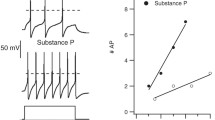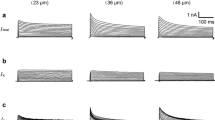Abstract
The effects of capsaicin were tested on 221 acutely isolated dorsal root ganglion neurons of the rat, which ranged in diameter from 15 to 55 μm. In a subpopulation of these cells, ranging in diameter from 17.5 to 33 μm (n=117), capsaicin (1 μM) produced an inward shift in holding current that was associated with an increase in membrane conductance in most cells (114 of 117). These effects of capsaicin were reversible upon washout of the drug. Other cells ranging in diameter from 15 to 52.5 μm (n=104) were unaffected in this manner by the 1 μm concentration of capsaicin. Capsaicin-sensitive cells had, on average, significantly longer duration action potentials and expressed significantly less IH than capsaicin-insensitive cells. The relatively long duration action potentials and/or small cell body diameter and paucity of IH observed in most of the capsaicin-sensitive cells is consistent with their representing C- or Aδ-type sensory neurons.
Similar content being viewed by others
References
Baumann TK, Simone DA, Shain CN, LaMotte RH (1991) Neurogenic hyperalgesia: the search for the primary cutaneous afferent fibers that contribute to capsaicin-induced pain and hyperalgesia. JNeurophysiol 66:212–227
Foster RW, Ramage AG (1981) The action of some chemical irritants on somatosensory receptors of the cat. Neuropharmacology 20:191–199
Harper AA, Lawson SN (1985a) Conduction velocity is related to morphological cell type in rat dorsal root ganglion neurones. J Physiol (Lond) 359:31–46
Harper AA, Lawson SN (1985b) Electrical properties of rat dorsal root ganglion neurons with different peripheral nerve conduction velocities. J Physiol (Lond) 359:47–63
He X, Schmidt RF, Schmittner H (1988) Effects of capsaicin on articular afferents of the cat's knee joint. Agents Actions 25:222–224
Heyman I, Rang HP (1985) Depolarizing responses to capsaicin in a subpopulation of rat dorsal root ganglion cells. Neurosci Lett 56:69–75
Holzer P (1991) Capsaicin: cellular targets, mechanisms of action, and selectivity for thin sensory neurons Pharmacol Rev 43:143–201
Kaufman MP, Iwamoto GA, Longhurst JC, Mitchell JH (1982) Effects of capsaicin and bradykinin on afferent fibers with endings in skeletal muscle. Circulation Res 50:133–139
Kenins P (1982) Responses of single nerve fibers to capsaicin applied to the skin. Neurosci Lett 29:83–88
Liu L, Simon SA (1994) A rapid capsaicin-activated current in rat trigeminal ganglion neurons. Proc Natl Acad Sci USA 91:738–741
Longhurst JC, Kaufman MP, Ordway GA, Musch TI (1984) Effects of bradykinin and capsaicin on endings of afferent fibers from abdominal visceral organs. Am J Physiol 247:R552-R559
Mayer ML, Westbrook GL (1983) A voltage-clamp analysis of inward (anomalous) rectification in mouse spinal sensory ganglion neurones. J Physiology (Lond) 340:19–45
Marsh SJ, Stansfeld CE, Brown DA, Davey R, McCarthy D (1987) The mechanism of action of capsaicin on sensory C-type neurons and their axons in vitro. Neuroscience 23:275–289
Scroggs RS, Todorovic S, Anderson EG, Fox AP (1994) Variation in IH, IIR, and ILEAK between acutely isolated adult rat dorsal root ganglion neurons of different sizes. J Neurophysiol 71:271–279
Seno N, Dray A (1993) Capsaicin-induced activation of fine afferent fibres from rat skin in vitro. Neuroscience 55:563–569
Szolcsanyi J (1987) Selective responses of polymodal nociceptors of the rabbit ear to capsaicin, bradykinin and ultra-violet irradiation. J Physiol (Lond) 388:9–23
Szolcsanyi J, Anton F, Reeh PW, Handwerker HO (1988) Selective excitation by capsaicin of mechano-heat sensitive nociceptors in rat skin. Brain Res 446:262–268
Todorovic S, Anderson EG (1992) Serotonin preferentially hyperpolarizes capsaicin-sensitive C-type sensory neurons by activating 5-HT1A receptors. Brain Res 585:212–218
Urban L, Dray A (1993) Actions of capsaicin on mouse dorsal root ganglion cells in vitro. Neurosci Lett 157:187–190
Utzschneider D, Kocsis J, Devor M (1992) Mutual excitation among dorsal root ganglion neurons in the rat. Neurosci Lett 146:53–56
Williams JT, Zieglgansberger W (1982) The acute effect of capsaicin on rat primary afferents and spinal neurons. Brain Res 253:125–131
Author information
Authors and Affiliations
Rights and permissions
About this article
Cite this article
Del Mar, L.P., Cardenas, C.G. & Scroggs, R.S. Capsaicin preferentially affects small-diameter acutely isolated rat dorsal root ganglion cell bodies. Exp Brain Res 111, 30–34 (1996). https://doi.org/10.1007/BF00229552
Received:
Accepted:
Issue Date:
DOI: https://doi.org/10.1007/BF00229552




